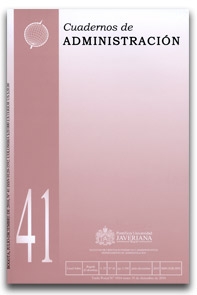Abstract
The use of derivative instruments is especially important in risk management because it directly influences the net worth of organizations and their potential to generate value. This study explores an explanatory hypothesis for the Colombian industrial and commercial companies’ use of derivative instruments before the Colombian Stock Exchange Derivatives Market opened. This article analyzes two hypotheses proposed in international literature: the use of derivative instruments by companies suffering from financial stress or enjoying financial sophistication and a combination of the two. To do so, a logistic regression model was used, which evidences that, in the case of Colombian companies, financial stress and financial sophistication are important reasons for using derivative instruments.
Allayannis, G. and Ofek, E. (2001). Exchange Rate exposure, hedging, and the use of foreign currency derivatives. Journal of International Money and Finance, 20, 273-296.
Allayannis, G. and Weston, J. P. (2001). The use of foreign currency derivatives and firm market value. Review of Financial Studies, 14 (1), 243-276.
Allayannis, Y.; Lel, U. and Miller, D. (2003). Corporate governance and the hedging premium around the world. Working paper. Virginia: Darden School of Business.
Bartram, S.; Brown, G. and Fehle, F. (2004). International evidence on financial derivatives usage. Mimeo.
Bessembinder, H. (1991). Forward contracts and firm value: investment incentive and contracting effects. Journal of Financial and Quantitative Analysis, 26 (4), 519-532.
Brown, G. (2001). Managing foreign exchange risk with derivatives. Journal of Financial Economics,60 (2-3), 401-449.
Campbell, T. S. and Kracaw, W. A. (1987). Optimal managerial contracts and the value of corporate insurance. Journal of Financial Quantitative Analysis, 22 (3), 315-328.
Carter, D.; Rogers, D. and Simkins, B. (2003). Does fuel hedging make economics sense?: The case of the US airline industry. Working paper. Oklahoma: Oklahoma State University.
Core, J. E.; Guay, W. R. and Kothari, S. P. (2002). The economic dilution of employee stock options: Diluted EPS for valuation and financial reporting. Accounting Review, 77 (3), 627-653.
DeMarzo, P. and Duffie, D. (2002). Corporate incentives for hedging and hedge accounting. Review of Financial Studies, 8 (3), 743-71.
Dolde, W. (1995). Hedging, leverage, and primitive risk. Financial Management Collection, 2 (1), 6-7.
Froot, K. A.; Scharfstein, D. S. and Stein, J. C. (1993). Risk management: coordinating corporate investment and financing policies. Journal of Finance (48), 1629-1658.
Géczy, C.; Minton, B. A. and Schrand, C. (1997). Why firms use currency derivatives. Journal of Finance, 52 (4), 1323-1354.
Graham, J. and Rogers, D. (2002). Do firms hedge in response to tax incentives? The Journal of Finance, 57 (2), 815-839.
Guay, W. and Kothari, S. P. (2003). How much do firms hedge with derivatives? Journal of Financial Economics, 70 (3), 423-461.
Gyoshev, S. B. (2001). Synthetic repurchase programs through put derivatives: theory and evidence. Tesis de PhD no publicada, Drexel University.
Han, L. M. (1996). Managerial compensation and corporate demand for insurance. Journal of Risk and Insurance, 63 (3), 381-404.
Haushalter, G. D. (2000). Financing policy, basis risk, and corporate hedging: evidence from oil and gas producers. Journal of Finance, 55 (1), 107-152.
Howton, S. D. and Perfect, S. B. (1998). Currency and interest-rate derivatives use in US firms. Financial Management, 27 (4), 111-120.
Knopf, J.; Nam, J. and Thornton, J. (2002). The volatility and price sensitivities of managerial stock option portfolios and corporate hedging. Journal of Finance, 57 (2), 801-813.
Lel, U. (2003). Corporate hedging policy around the world. Working paper. Indiana: University of Indiana.
Leland, H. (1998). Agency costs, risk management, and capital structure. Journal of Finance, 53 (4), 1213-1243.
Lookman, A. (2003). Does hedging really affect firm value? Working paper. Pittsburgh: Carnegie Mellon University.
Martín, M.; Rojas, W.; Eráusquin, J.; Yupanqui, D. and Vera, D. (2009). Derivatives usage by nonfinancial firms in emerging markets: the Peruvian case. Journal of Economics, Finance and Administrative Science,14 (27), 73-86.
Mayers, D. and Smith Jr., C. W. (1982). On the corporate demand for insurance. Journal of Business,55 (2), 281-296.
Merton, R. (1973). Theory of rational option pricing. The Bell Journal of Economics and Management Science, 4 (1), 141-183.
Mian, S. L. (1996). Evidence on corporate hedging policy. Journal of Financial and Quantitative Analysis,31 (3), 419-439.
Myers, S. C. (1977). Determinants of corporate borrowing. Journal of Financial Economics, 5, 147-175.
Myers, S. C. (1984). The capital structure puzzle. Journal of Finance, 39 (3), 575-592.
Still searching for optimal capital structure. (1993). En J. M. Stern and D. H. Chew, Jr. (Eds.), The revolution in corporate finance (pp. 91-99). New York: Basil Blackwell.
Nain, A. (2005). The strategic motives for corporate risk management. Job Market Paper. Department of Finance, University of Michigan.
Nance, D.; Smith, C. and Smithson, C. (1993). On the determinants of corporate hedging. Journal of Finance, 48, 267-284.
Purnanandam, A. (2004). Banks hedge in response to the financial distress costs? (Reseña). Revista de la Escuela Colombiana de Ingeniería, 15, 59.
Schrand, C. and Unal, H. (1998). Hedging and coordinated risk management: evidence from thrift conversions. Journal of Finance, 53 (3), 979.
Shapiro, A. C. and Titman, S. (1986). An integrated approach to corporate risk management. En J. M. Stern and D. H. Chew (Eds.), The revolution in corporate finance (pp. 215-229). New York: Basil Blackwell.
Smith, C. W. and Stulz, R. M. (1985). The determinants of firms' hedging policies. Journal of Financial and Quantitative Analysis, 20 (4), 391-405.
Stulz, R. M. (1984). Optimal hedging policies. Journal of Financial and Quantitative Analysis, 19 (2), 127-140.
Managerial Discretion and Optimal Hedging Policies. (1990). Journal of Financial Economics 26:1: 3-27.
Tufano, P. (1996). Who manages risk?: An empirical examination of the risk management practices in the gold mining industry. Journal of Finance, 51 (4), 1097-1137.
Warner, J. B. (1977). Bankruptcy costs: some evidence. Journal of Finance, 32 (2), 337-347.
This work is licensed under a Creative Commons Attribution-NonCommercial-ShareAlike 3.0 Unported License.


